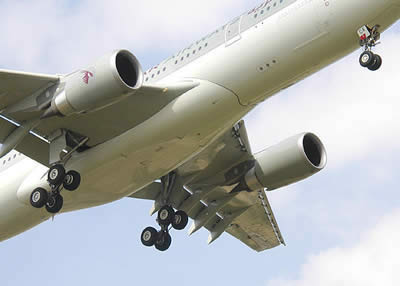Le bruit aérodynamique généré par les systèmes hypersustentateurs1 et les trains d’atterrissages constitue la source prépondérante du bruit externe des avions civils gros-porteurs en phase d’approche. La prévision numérique de ce bruit représente donc un enjeu critique pour les constructeurs.
*CFD : Computational Fluid Dynamics
ou Simulation numérique des écoulements

The external noise of an airliner in the approach phase is essentially aerodynamic and mostly comes from the friction of the air on the structure of the landing gear. CFD is beginning to seriously address this problem.
The aerodynamic noise generated by the lift augmenting1 and landing gear systems constitutes the major source of the exterior noise of jumbo jets in the approach phase. The numerical forecasting of this noise therefore represents a crucial factor for manufacturers.
This noise is a result of multiple interactions between the turbulent flows and the various elements that make up the cell. Predicting it requires firstly the accurate computation of the flows, and more specifically their unsteady or fluctuating components which constitute the sources of noise.
The aeroacoustic simulations are thus based on flow calculations (CFD), most often based on the method of simulation of large scales or LES2 (Large Eddy Simulation), and its hybrid variants RANS3/LES, such as ZDES4 (Zonal Detached Eddy Simulation).
With regard to the landing gear, the complexity of the three-dimensional geometries has for a long time limited the application of these methods to realistic configurations because of the difficulty of generating the necessary meshes, particularly the multi-domain structured meshes5, the only ones compatible with the elsA software.
The Lagoon program - structured CFD with elsA
![Visualization of the turbulent structures and acoustic waves around the Lagoon landing gear [calculation with elsA 3.3]](/sites/default/files/actualites/magazine/image_du_mois/2011-aeroacoustique-train-atterrissage-lagoon-elsa.jpg)
Visualization of the turbulent structures and acoustic waves around the Lagoon landing gear [calculation with elsA 3.3]
In order to assess existing techniques for simulation of landing gear noise, Airbus launched the Lagoon program in 2006, in partnership with Onera, the DLR and the University of Southampton, with the objective of comparing these methods using a landing gear geometry that was highly-simplified, but representative of the mechanisms present on real landing gear.
To validate these methods, an experimental database was assembled in the project by Onera in its F2 and Cepra19 wind tunnels. Moreover, Onera successfully carried out a simulation by ZDES with the elsA simulation software, based on a structured5 multi-block mesh of approximately 34 million points.
This unsteady calculation was extended by a calculation of the noise radiation using an integral method (Kim code). The comparison with the experimental aerodynamic and aero-acoustic results is very satisfactory.
Pressure fluctuations in a median plane showing both the convection of the wake and the generation of acoustic waves
With Nasa, non-structured CFD using Cedre
![Appearance of the turbulent flow on a background of non-structured mesh [Cedre Calculation]](/sites/default/files/actualites/magazine/image_du_mois/2011-aeroacoustique-train-atterrissage-cedre-renew.jpg)
Appearance of the turbulent flow on a background of non-structured mesh [Cedre Calculation]
Non-structured6 type meshes, compatible with the Cedre CFD solver, can considerably reduce the difficulties encountered in the construction of structured multi-block meshes. However, the implementation of the DES for Cedre is less proven than for elsA (Cedre uses the DDES method - Delayed Detached Eddy Simulation).
Within the framework of cooperation with Nasa, this experiment was extended to configurations of landing gear proposed by Nasa for which experimental aerodynamic and acoustic data were also available.
After an initial approach on an academic geometry composed of two parallel cylinders, Onera used a very realistic geometry for the nose gear of a corporate aircraft on a ¼ scale.
A mesh of 12 million tetrahedrons was built, with which a DDES calculation gave aerodynamic results in good agreement with the steady and unsteady pressure and speed measurements recorded by Nasa in its BART wind tunnel. An acoustic use of this calculation was then carried out with the Kim code, and the radiated noise results were compared with the measurements made for Nasa by the University of Florida in its acoustic wind tunnel, again with very promising agreement.
View of the vortical structures which are the source of the aerodynamic noise of the landing gear
Glossary
- 1 Lift augmenting systems
Systems the function of which is to increase the lift capability. These are generally leading edge slats and trailing edge flaps. - 2 LES - Large Eddy Simulation
Technique for the solving of turbulent flow equations in which the large scales of movement are solved explicitly while the small scales (smaller that the calculation meshes) are modeled by a "vortical viscosity" term. - 3 RANS - "Reynolds-averaged Navier–Stokes" Equations
These are equations that describe eddy flows but which involve simplifying hypotheses. In particular, they are averaged over time and are best suited to relatively steady flows. - 4 ZDES - Zonal Detached Eddy Simulation
A method allowing for the cohabitation within the same simulation of a RANS type model and a LES type model, localized in the separated zones. This means that the most efficient (and more costly) method is only used when it is really necessary, resulting in acceptable simulation times. This method was developed at Onera. - 5 Structured mesh
Discretization of the space with hexahedric meshes. These meshes are designated by indexing (i,j,k) in a NixNjxNk set (implicit structure). A method that increases both rapidity and accuracy of the computations. Several meshes (blocks) can be juxtaposed to describe complex geometries. - 6 Non-structured mesh
Discretization of the space using meshes of various shapes (tetrahedron, pentahedron, hexahedron... and various polyhedrons [with Cedre]). These meshes are distributed according to a structure which must be explicitly described. A method suitable for the discretization of complex shapes.




